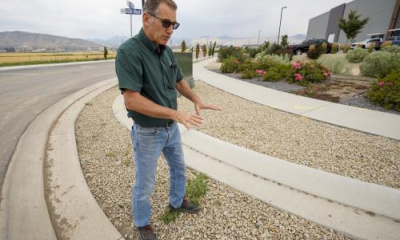This Great Salt Lake Collaborative story is part of day one of our series, “At water’s edge: Searching for solutions at the Great Salt Lake’s sister lakes across the Great Basin.” The in-depth project features the work of multiple journalists from multiple Utah news organizations.
Click here to learn why we went to California and to experience photos, videos, interactive maps and stories:
VISIT INTERACTIVE PRESENTATION »
SALT LAKE CITY — More than 90% of Utahns live in the Great Basin, which is a region between the Rocky Mountains, including the Wasatch on the East, and on the West, the Sierra Nevada.
In total, there are more than 200,000 square miles that are entirely reliant on mountain streams since there is no outlet for water.
A coalition of media outlets, called the Great Salt Lake Collaborative, is shining a light on Utah's most under-appreciated and most threatened natural wonder: The Great Salt Lake.
This week, FOX 13 News will introduce you to what we can learn in Utah about the lake and what has been done elsewhere as water levels decline.
The collaborative sent a team of journalists to two lakes in the shadow of the sierra mountains. It was meant to serve as an example of what can happen when a big city takes water from a saltwater lake.
In the early 20th century, Los Angeles looked North for water and bought the rights to the Owens river. Then, they built an aqueduct to quench its thirst, which eventually turned Owens lake into a dusty disaster.
"We had dust storms quite frequently," explained Chris Langley. "They were so severe that we had to stop the kids playing outside."
In 2004, a judge ordered Los Angeles to mitigate the dust, which has been an ongoing $2.5 billion effort.
However, the Owens river wasn't enough for America's second-biggest city. They looked even further north, stretching the aqueduct 350 miles to creeks feeding into Mono Lake.
Mono Lake was close to becoming just like Owens Lake, but today, it's alive with birds and brine shrimp.
The lessons from Mono and Owens lakes may hold the keys to saving the Great Salt Lake.
FOX 13 News will look at both models in-depth this week as a much larger crisis looms ahead of Utah. Threats are at our doorstep as the current drought has already exposed far more lakebed than Owens and Mono Lakes combined.
Each day, partners in the Great Salt Lake Collaborative will share their stories in print, online, radio and television formats and we'll work with a scientist from Salt Lake Community College to build a resource for learning and solutions.
What's your response to At Water's Edge?
Does this reporting project make you feel hopeful? Concerned? Inspired? Surprised?
Selected responses will be used on social media, on our website or in our newsletter.








